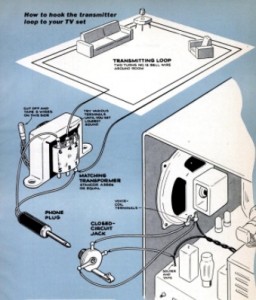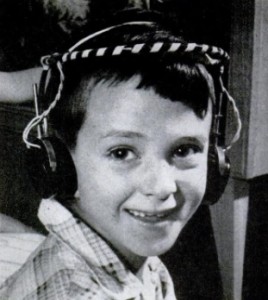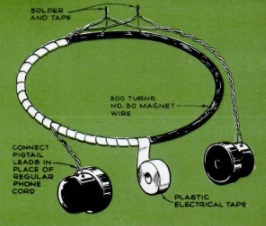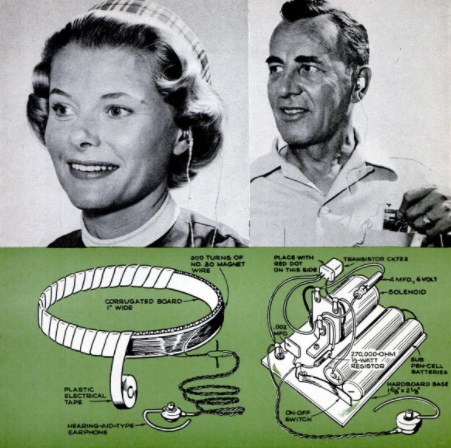Sixty years ago, domestic tranquility was restored in this household, as shown in this picture from the October 1957 issue of Popular Science. Dad and Junior can watch the fight, while Mom and Little Sister work on the piano lessons.
This major breakthrough was accomplished after extensive testing by the editors of the magazine. Every TV owner had been waiting for the good news: “a simple way for each member of the family to turn the sound off or on, to suit himself, without annoying anyone else.”
The magic that made this possible was the inductive loop. Because the headset was wireless, “there’s no dangling cord to tether you to the console.” The headsets could be made in a couple of hours, and the magazine proposed three varieties.
 The modification of the set and the installation of the loop was an almost trivial matter. The magazine warned to unplug the set and let it sit for 15 minutes “for the tubes to cool off” (and hopefully for the electrolytics in the power supply to lose some of their charge). Then, the lead to the speaker was snipped and hooked to the inductive loop, as shown here. The magazine recommended adding the closed-circuit jack shown in the circuit here, so that the loop could be unplugged on those occasions when the speaker was desired.
The modification of the set and the installation of the loop was an almost trivial matter. The magazine warned to unplug the set and let it sit for 15 minutes “for the tubes to cool off” (and hopefully for the electrolytics in the power supply to lose some of their charge). Then, the lead to the speaker was snipped and hooked to the inductive loop, as shown here. The magazine recommended adding the closed-circuit jack shown in the circuit here, so that the loop could be unplugged on those occasions when the speaker was desired.
The loop could be run under the carpet, as shown here, tucked away near the ceiling, or even placed in the joists in the basement below. While reception was best when the headsets were at the same level as the loop, the magazine’s tests showed that any of these arrangements would work well.
 This loop formed the primary winding of a room-sized audio transformer. The secondary windings would be in the individual headsets. For the kids, the magazine recommended the spaceman style shown here, with the assurance that the kids would love them.
This loop formed the primary winding of a room-sized audio transformer. The secondary windings would be in the individual headsets. For the kids, the magazine recommended the spaceman style shown here, with the assurance that the kids would love them.
As revealed by the diagram below, these headsets were simplicity itself. The coil was worn around the head, and hooked directly to the headphones. The magazine suggested that Mom should be put in charge of suitably decorating the loop with colored tape. No other electronics were necessary for these headphones for the kids. The output of the coil was sufficient to drive the headphones.
Mom and Dad warranted somewhat more discrete looking receivers, and these could be either of the models shown below. Mom had a version similar to the kids’ version, but the loop was not worn. It was apparently thought that she could set it in a convenient spot, and it was hooked directly to a small earphone. The magazine noted that the earphone was so small that it could hardly be seen. The only problem that might result would be forgetting to take it off before going to bed!
Dad is seen using a slightly more complicated version, but still easily within the capabilities of anyone able to wire up a lamp cord. It used a much smaller coil, amplified with the venerable CK722 transistor. It was the size of the proverbial pack of cigarettes, and the two penlight batteries would keep it running for a thousand hours.
Those wishing to duplicate this idea today can save a great deal of coil winding time by using a telephone pickup coil instead of winding the coils for the individual receivers. If a set of high-impedance headphones is available, it could be fed without any electronics. The CK722 is more or less unobtainium, except at very high prices. But any small audio amplifier could be put into service. If you want to make your own, hundreds of circuits are available using the readily available 2N2222 transistor.



